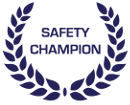
Strategies to include all your employees in the workplace safety culture
When implementing safety policies and procedures in our workplaces, the focus is often on our permanent employees. But did you know that temporary and casual employees, and contractors, are more prone to health and safety risks?
Organisational issues such as economic or reward pressures, inadequate implementation of supervision, ambiguity in rules and procedures, improper training, and more complicated lines of management reporting often result in the staff that aren’t always front of mind slipping through the safety cracks and experiencing workplace incidents.
It’s a serious issue, but one that can be easily addressed. It’s about ensuring you dedicate the right attention to communicating your health and safety materials, coordinating the right training, supervision and induction to all staff who begin working at your business-whether they are there for a short or an extended period of time.
Communication is Key
An easy way to ensure you start as you mean to go on is to implement an arrival induction even before any temporary contractors or suppliers start tasks on your site.
It is important for both you and your onboarding staff members that the basics of safety and health requirements of the site, and expectations around what to do in case of an incident or risky situation are clear and understood by both parties. In this way, inductions and safety talks are key to ensure these colleagues know the safety rules and understand the main hazards of the jobs they are running.

This communication can be performed effectively using the forms in Safety Champion’s Communication Module. You can send out templates such as:
- An arrival induction form including messages and videos for onboarding employees to learn and to be informed about your organisation’s health and safety protocols.
- A pre-engagement email automatically generated for a new contractor that contains health and safety training modules. This will ensure the contractor has the company knowledge and follows and accepts the safety and health practices of the site or company who is hiring them.
- Site check-in and check-out forms with safety instructions and requirements; these can be set up in the Safety Champion Site Attendance Module.
Check your Invite List
Temporary workers, contractors and suppliers operating on your worksite should always be invited to relevant safety meetings in the same way that you invite your regular employees.
This is such a simple but also crucial opportunity to ensure that all staff, no matter what level of employment they have within your organisation, do not miss the chance to know what is going on concerning health and safety within your workplace. Safety meetings should be conducted as regularly as possible.
You can also use these meetings to ensure temporary staff are up to date with the latest health and safety procedures implemented, and they can also gain insight on or share from their own experience on opportunities for continuous improvement in your workplace.
Health and Safety KPIs
It is a great idea to include the health and safety metrics associated with your contracted resources, for example, the number of near misses or hazards reported, within your overall safety KPIs.
If the companies that employ your temporary workers, contractors and suppliers are aware that their safety metrics are overseen by your organisation’s management, it is more likely that they will take the health and safety of the staff contracted to your organisation more seriously.
This will also enable your temporary staff to feel more encouraged to report hazards or improvement opportunities within your workplace.
Regular Leadership Check-ins
A recurring performance review meeting with the leadership team of the contractor or supplier companies working on-site is essential to reinforce the safety message and expectations of the company.
Moreover, if the leadership positions within the contractors and suppliers are clear about safety expectations, it is more likely that the safety message is properly shared and communicated to the rest of their staff.

So, there you have it. If you implement simple strategies that can help employers get started, no matter their level or hours they are contracted to work, you’ll be on the road to ensuring the health and safety of everyone who helps make your business a success.
To help ensure your safety communication reaches all your employees, sign up for a trial of Safety Champion Software.



